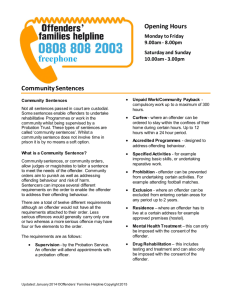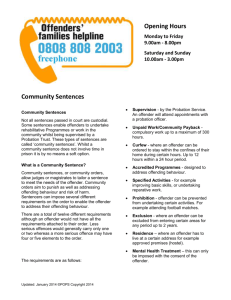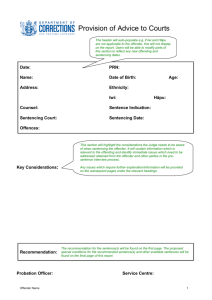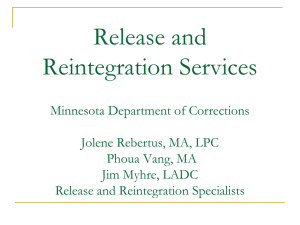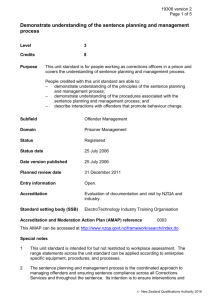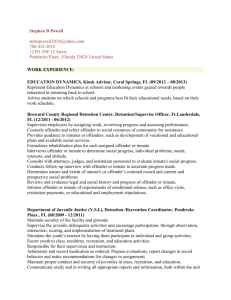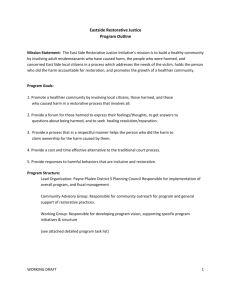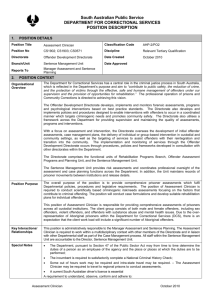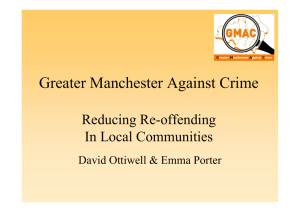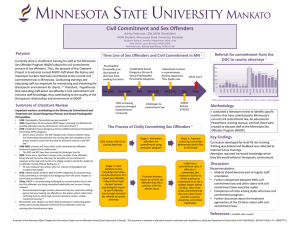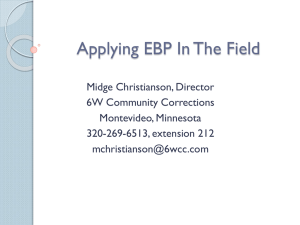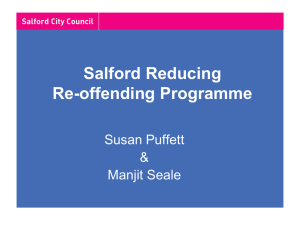PowerPoint Presentation - Jan
advertisement
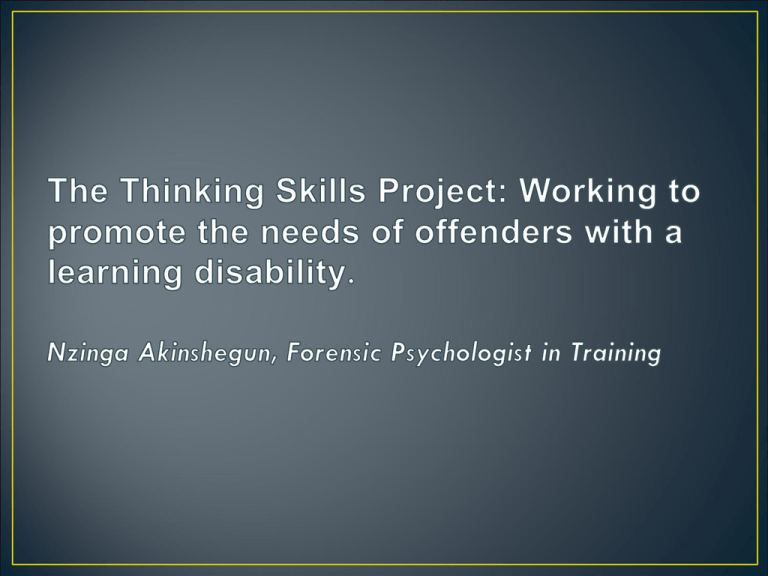
To be given information on the background context of the Adapted Thinking Skills Project (ATSP). To understand the ATSP programme. To understand the adaptations made to the Thinking Skills Programme. To be introduced to preliminary evaluation results. The general consensus among professionals is that there exists an overrepresentation of people with LD in the criminal justice system. 20-30% of people involved in the criminal justice system have a learning disability or difficulty (Talbot, 2008). Prisoners with learning disabilities/difficulties were three times more likely to suffer with depression & anxiety compared to the comparison group. Prisoners with learning disabilities/difficulties were three times more likely to have spent time in segregation. Prisoners with learning disabilities/difficulties were least likely to access offending behaviour programmes, and were the least likely to know when their release date was and were more likely to have been bullied. Poor identification procedures Lack of diversionary options AA provision Lack of staff training (police, court staff) OBP’s are designed to facilitate the rehabilitation of offenders. Through a series of activities the programmes help the offender reduce their chances of reoffending. Programmes vary in complexity and length and range from sexual offender programmes to general offending behaviour programmes. Accredited programmes are evidenced based. The Thinking Skills Programme is a NOMS accredited offending behaviour programme that aims to help offenders address their offending behaviour. The programme targets deficits that are linked to offending behaviour such as impulse control, interpersonal relating and cognitive distortions. The current Thinking Skills Programme is designed for offenders with an IQ of 80 or above. Eligibility is also based on the offenders level of risk and whether their offending needs match what the programme can offer. 3 modules of 5 sessions each (The self-control, problem solving and relationships module). In addition, there are four 1:1 sessions, with each offender being assigned a facilitator to work with during ‘private sessions’. Due to the programmes IQ criteria it means that offenders with an IQ below 80 will be unable to benefit from the programme. This is a real problem because 25% of prisoners have an IQ between 70-79 (Talbot, 2012). This has led to concerns that NOMS were potentially failing in their duty to provide a service to all prisoners. It could be argued that professionals at all levels are starting to develop an awareness of the difficulties that LD persons are facing in the Criminal Justice System. My manager (Alison Giraud-Saunders) applied for funding in 2009 from DH to adapt the Thinking Skills Programme. Funding was granted in 2010. Dr. Peter Oakes and Professor Glynis Murphy were our project consultants. NOMS were very much an active part of the adaptation process. They were keen to ensure that we stayed true to the integrity of the programme and the underlying theory base. The adapted version of the Thinking Skills Programme is 26 sessions long. Module 1 self-control: 10 sessions long. Module 2 Problem solving: 5 sessions long. Module 3 Positive relationships: 6 sessions long. There are five 1:1 sessions: one pre-group meeting, three in between module sessions and one end of programme session. Self-control This module focuses on the offender with learning disabilities thinking and talking about all of the risk factors that led to his index offence. We use a combination of pictures and role plays to help the offender identify and manage their risk factors. The programme therefore teaches self-control, i.e. to stop and think before a decision is made. The identification of risk of offending and a lack of impulse control is very often what is missing within the offender’s skill sets. The problem solving module This module helps the offender to become good problem solvers. It conceptualises a problem into four stages: 1. knowing the problem 2. brainstorming 3. choose an option 4. Make a plan. Through various exercises the offender basically goes through the skills steps several times over with their own problems and through exercises generated by the facilitator. The positive relationships module This module is concerned with the offender identifying pro-social and non pro-social people within their current social circle. The second half of the module then focuses on the offender developing specific skills in order to maintain and develop pro-social connections. The skills looked at include perspective taking, negotiation and assertive communication. The main adaptations therefore included: Eligibility Increase in programme length Language Memory Fictional characters Easy read The evaluation was led by Dr. Peter Oakes and was conducted on all three prisons we worked in. The evaluation we used is known as realistic evaluation (Tiley, 1997) and included collecting specific pieces of information regarding the prison. this was all with the aim of trying to ascertain whether the programme could be successfully implemented in different environments. Feasibility not effectiveness Although evaluating the effectiveness of the programme was not a project aim, Professor Glynis Murphy and I carried out some pre and post testing on offenders who underwent ATSP. The post psychometrics included 1. Locus of control: (Goodman, Leggett & Garett, 2007). The locus of control comprises of 16 questions, each answered yes or no along with cartoon based scenarios in which the offender has to ascertain responsibility for the characters action. 14 12 10 Post Loc scores 8 Pre Loc scores 6 4 2 0 wy1 wy2 wy3 wy4 wy5 wy6 wy7 wy8 The problem solving measure consists of 10 problem statements which require the offender to generate a number of alternatives to solving the problem. The measure is scored for number of assertive ideas, passive ideas, aggressive ideas & total number of ideas. 35 30 25 20 No. of assertive ideas (Pre prog) No. of assertive ideas (post prog) 15 10 5 0 wy1 wy2 wy3 wy4 wy5 wy6 wy7 wy8 CSAAP Publications Reports and evaluation Promote the work


